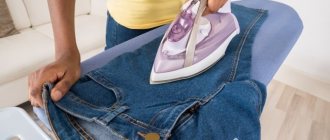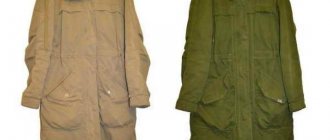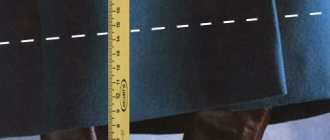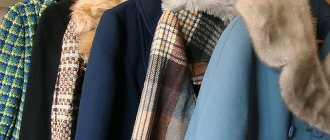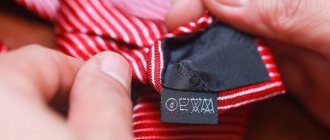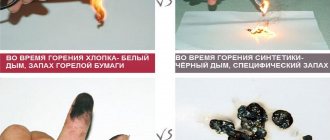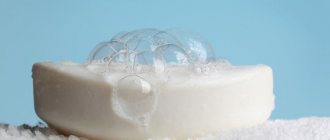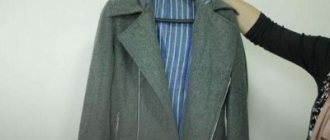During long-term storage in a closet or after improper washing, a coat may become wrinkled and lose its attractive appearance.
In such situations, it becomes necessary to iron outerwear. But how to properly iron a coat?
In order not to spoil the product, it is important to know some rules for caring for it, depending on the type of material from which it is made.
How to smooth out a wrinkled item after washing or purchasing?
Sometimes it is still not possible to avoid the formation of folds. Creases and wrinkles may appear due to improper storage or washing. Often a crumpled item is given when purchased in a store, where it is kept folded in plastic bags. How to iron a down jacket without damaging the fabric and filling?
Can I use an iron?
What to do if a new down jacket gets wrinkled while being stored in a store? Before using the iron, you should look at the down jacket label. A pictogram in the form of an iron indicates that ironing is acceptable. The number of dots inside the icon indicates the temperature at which ironing is possible. If the ironing symbol is crossed out, then using the iron is strictly prohibited.
Most often, down jackets are made from polyester. Polyester cannot be ironed at temperatures above 110 degrees. Before ironing the item, it should be laid out on a horizontal surface (ironing board or table) and the folds should be ironed out. The item is turned inside out and the lining is ironed. Then iron the front side. If the jacket is thin, without a dense layer of filler, then with shallow folds, ironing from the inside will be enough, the outer side will also be smoothed out.
It is strictly forbidden to iron a wet product; it must be absolutely dry. Do not touch the fabric with an iron without an ironing iron, which can be used as cotton fabric or gauze. The fabric is lightly moistened in water, laid out on the front surface of the down jacket, and the item is ironed through it. If necessary, iron the product on the lining side as well.
If you have a steamer
The second option for smoothing out wrinkles on a down jacket involves using a steamer. A regular iron with a vertical steam function will also work. Steam ironing is indispensable when the fabric of a down jacket or winter jacket cannot be ironed. For example, leather products can be steam treated.
How to determine whether steaming is prohibited? On the reverse side of the label there will be an ironing icon with crossed out lines at the bottom.
Before steaming, the item should be washed and hung on a hanger. For convenience, you can stuff your sleeves and shoulders with rolled towels. It is recommended to fill the steam generator tank with filtered water to prevent contamination of the material.
You need to start steaming with small parts - collar, sleeves, cuffs, pockets, and then move on to the main part. First, the fabric is heated at a distance of 25–30 cm, gradually bringing it closer to the item. Do not bring the iron or steam generator closer than 10–15 cm, as this can lead to damage to the material.
Steam room for a down jacket
What to do if you don’t have an iron or steamer at hand? In this case, you can arrange a steam bath at home:
- the product is placed on a hanger above the bathtub;
- all folds are straightened out so that there are no strong creases in the items;
- turn on the hottest water possible, from which steam will rise;
- The drain in the bathtub should not be closed so that the water does not overflow onto the floor;
- The door to the room is closed, and cracks are plugged if necessary.
To keep the bath water from cooling longer, you can add a little salt to it. However, you should not add too much salt, otherwise it will settle on the fabric of the down jacket.
This “steam room” helps smooth out even the deepest wrinkles. The down jacket is saturated with steam, and under the influence of the gravity of the water and high temperature, the material expands. After steaming, the product must be dried.
To iron an item using steam, you can use a gas stove. The item is hung over pots of boiling water. This method is quite dangerous, so someone must be in the kitchen at all times.
Regular ironing
Polyester outerwear rarely wrinkles. This only happens after washing, so the main thing is to properly dry wet synthetics. And minor drying defects should be eliminated with an iron.
First, iron the patch, which is usually sewn on the wrong side of the product, and adjust the heating temperature on it.
- If the coat is made of polyester with a thin fabric lining, then the product can be ironed by ironing only on the wrong side.
- If we are talking about winter clothes with insulation, iron the item from the front side, but always through a damp pad: gauze, thin cotton fabric that you can find at home.
Operating procedure
The order (sequence) of work when ironing a coat made of any material can be presented in the form of a step-by-step guide. The ironing process will vary depending on the device you choose.
Iron
For most coat styles, the ironing plan will look something like this:
Turn the crumpled coat inside out. Open the lining at the bottom of the garment, thereby providing access to the main material of the coat. If the lining is not sewn tightly at the bottom, then you can omit this step. Do not rip off the lining of coats made of Bolognese fabrics and outerwear made of light fabrics. Remember that the torn lining will need to be sewn back in its original place after ironing! Lay your coat out on a table or ironing board. Iron the burlap of the pockets and other small parts inside the product well. Prepare the fabric for the backing. Its length should be sufficient to fold several times. In this case, the multi-layer cut should cover at least a third of the back. This step can be omitted for those who will be ironing coats made of fabric that is not prone to sticking to the soleplate of the iron. Smooth the shoulder seams through the backing, maintaining the original direction of the cuts. Stretch the sleeves, following the folds, onto the sleeve ironer, iron the inside of the sleeve first, and then the outside. Complete the sleeve ironing process at the end. Iron all bulging places as the fabric lies. Iron the collar and lapels through the backing, and then the hems. Press the inside seams along the sides, ridges, and other curves. Turn the coat inside out and now iron it from the outside through a damp cloth (if the iron does not have a steam function) or through a dry cloth, starting from the collar and moving towards the hem
Pay special attention to cuffs, button areas and buttonholes. Iron all raised parts with light force.
Take note of this tip: always iron pile fabrics in the direction of the pile! To complete the process of ironing the coat, run the iron over the lining of the product.
Always remember that for each material you need to choose the appropriate heating temperature for the soleplate of the iron. We will tell you how not to make a mistake in choosing in the next section of this article.
As you can see, the process of ironing a coat with an iron is quite difficult and very lengthy. In addition, it requires extreme care from the performer and experience in processing complex details: sleeves, collars, ruffles and lapels.
Steam station or steamer
We are in a hurry to disappoint those who think that it is easier to iron a coat with vertical mailers or irons with a similar function. And all because the steps listed above from one to nine will have to be completed in any case.
The basic process using steam, described in step ten of the instructions for ironing a coat with an iron, is to process the product hanging on a hanger. It is not recommended to iron a coat while it is not hanging. Because:
- the fabric will get wet more than expected;
- you can ruin the surface on which the coat lies;
- It is difficult to apply steam to small parts (after all, they are smoothed out under their own weight).
Steam ironing works best if gentle detergents were used when washing and fabric softeners were used when rinsing. A positive feature of using steam units is that after such ironing there are no shiny stripes or scorched fibers left, and the product also smells of freshness, absorbed during air drying.
Steamers of any type are not recommended for use on partially washed items. This may cause stains and smudges.
Passive ironing
The ironing techniques described above are applicable exclusively to coats washed in a machine or by hand with a full immersion of the product. For coats that have been gently washed, you can use passive ironing. This option will also be the best choice when the outerwear is not very wrinkled. An unusual method can be implemented by following the instructions:
- Hang your coat on hangers.
- Fasten all buttons.
- Secure hangers over the bathtub or any other place where the coat can be hung at full length and a basin can be placed.
- Fill the container with boiling water, to which add a few tablespoons of salt.
- Leave the coat to hang over the steam until the water has completely cooled, and then take the product to a well-ventilated room to dry.
This method is especially good when you need to iron a coat made of drape or natural woolen fabric. However, it is not at all suitable for fabrics with synthetic fibers.
Ironing Tips
Frequent ironing is not recommended for outerwear, so it is better to avoid bruising. If, despite all precautions, it still loses its appearance, then you need to iron it in accordance with the recommendations:
- It is best to iron in a well-lit room during the daytime. The window should be on the left, the socket on the right.
- Before processing the collar, check for stains. Delete if they exist.
- If clothes have raised embroidery, it is better to smooth out the decor with steam so as not to wrinkle it.
- Knitted coats with a relief pattern are steam ironed while hanging. If necessary, on the table through a moistened iron, without pressure.
- Iron tweed items in the same way as wool items.
- If the product has decor or accessories made of delicate materials, then before steaming the coat, they must be covered with shreds.
- Before ironing the folds on a synthetic coat, they must be carefully straightened. It will be impossible to correct incorrectly ironed areas.
- Satin and twill linings are smoothed dry, as they lose their shine when wet.
- It is recommended to smooth the seams with the edge of the iron.
- To prevent the seams from imprinting when ironing a coat without a lining, you need to place strips of paper under them.
How to smooth difficult things with a steamer
What cannot be ironed well with an iron can be tidied up with a steamer.
Fur coat
It is very difficult to smooth out a natural fur coat on your own. If clothes have been stored incorrectly, they will go straight to the dry cleaner. But if you have a steamer at home, your fur coat will be ready to wear in a few minutes.
Place the fur coat on a flat surface. Warm up the device and pass it once over each part of the product. Then flip and repeat.
Trousers
Pants treated with a steam cleaner look five stars. Hang your trousers on the trempel with the waist down. Run the hot steam cleaner from top to bottom several times.
If you want to make straight arrows, your set of attachments should have the right ones. If you don't have one, use kitchen tongs. First, draw the crease with your hands, then run the steamer over the trousers and then form the crease with tongs.
How to smooth difficult things with a steamer
Delicate items
To iron delicate items, you need to reduce the power of the tool to half. If you do not have this function, simply increase the distance of the device from the fabric. Be sure to hang the delicate item on a trampoline so that the steam can pass through it.
Kids toys
It is very good to iron children's soft toys with steam. They become cleaner and completely disinfected. It is enough to treat toys once a week.
Put the device on full power, and then run it several times on each side of the toy. With regular cleaning, you won't even need to wash your stuffed toys.
How to iron with a steamer - a guide that will help you expand the use of your device at home.
How to do without ironing
In order not to look for a suitable method of ironing without an iron, you can simply prevent things from getting wrinkled. This can be done in several ways.
Choose a material that does not require ironing
The components of the material from which the product is made can significantly affect the degree to which the item is wrinkled. The more synthetic fibers a fabric contains, the less likely it is that creases and folds will occur.
If you prefer clothes made from natural cotton materials, give preference to fabrics marked “Non Iron”. Such products straighten under their own weight and do not require ironing.
Washing and drying mode
When washing and drying, adhere to the following rules:
- When washing automatically, select the “light ironing” or “no wrinkles” mode;
- do not set the spin mode to the minimum number of revolutions;
- When washing by hand, do not twist the clothes with your hands, but simply let the water drain;
- Shake the product thoroughly before drying;
- Try to dry clothes only on hangers, this way you will avoid kinks and marks from clothespins.
In addition, store your clothes properly. Keep it only hanging, and if it is impossible to hang it, fold it only at the seams or roll it with a roller.
Using a steamer
A technical replacement for an iron will be a steamer or steam generator. Each modification has its own technical and operational features.
The steamer resembles a vacuum cleaner in appearance, has a boiler, a hose and a special steam tube. The water is heated in the boiler and rises through a hose into a tube that releases steam under pressure. The steamer helps not only to smooth things out, but also to clean clothes and various surfaces from dirt.
The steam generator consists of an iron to which a water boiler is attached via a tube. The liquid is heated and forced through the iron under high pressure. Such devices are widely used in the professional field of processing and sewing clothes, as they can cope with even the most complex irregularities and folds.
Iron out a winter bolonese jacket
Cleaning up a down jacket at home is somewhat more difficult than a summer or mid-season polyester jacket. After mandatory checking of the fabric’s reaction to temperature and ironing method, the product is moistened. This can be done simply by leaving it suspended for a quarter of an hour in a closed bathroom where the hot water tap is open, or by wetting it and squeezing it out. Ironing begins from the wrong side. You can use a steamer or a damp cloth in combination with a hot iron. Upon completion of ironing, turn the item inside out; if there are folds on the outside, repeat the procedure.
It is important to note that the fabric on the back and front sides may react differently to temperature, so a preliminary check should be carried out with each of them
It is more convenient to iron down jackets or raincoats while hanging them using steam. To do this, place the item on hangers, fasten all the buttons or zippers, and then hang it up. The iron is set to iron delicate fabrics using steam, or you can use a steamer. The household appliance is kept at a distance of 3-10 cm (depending on the capabilities and operating features of the appliance) from the fabric. You should steam a bologna jacket moving from top to bottom, starting from the back. At the next stage, the sleeves of the product are exposed. Only after this can you steam your shoulders. Ironing is completed by working on the front of the jacket. After this, the item is left to cool and dry completely. When dry, the fabric is resistant to new kinks or wrinkles.
A polyester jacket will reliably protect its owner in any weather and look great if you follow simple rules for caring for it. Careful washing in cool water and ironing using steam will ensure the fabric is perfectly smooth and the jacket is attractive. It is recommended to store the already ironed item on hangers to avoid kinks and not return to the grueling ironing procedure.
Helpful care tips
Caring for your coat requires compliance with the following rules:
- When washing, do not rub the product; it is better to gently squeeze it with your hands and turn it over in the water. Before machine washing, place the item in a special laundry bag. After such washing, the product will have no deep wrinkles.
- Do not twist or wring the coat. Just hang it over the basin to drain off excess liquid. Otherwise it will be wrinkled.
- To make the fabric softer and more flexible, use a special conditioner. After washing this way, there will be no wrinkles on the clothes.
- When ironing, adjust the temperature correctly. To do this, before the procedure, study the label from the reverse side.
- It is difficult to iron a dry coat made of coarse wool, so do not dry it completely.
- After ironing, let the product cool and only then put it on or hang it on a hanger.
To keep your favorite coat pleasing to the eye longer, follow the care instructions. Be sure to read the information on the label before each procedure (washing, ironing, steaming). If it is possible or the item is very expensive, then take it to the dry cleaner. Specialists will quickly restore the original appearance of a coat even from the most capricious fabric.
How to iron a jacket: step-by-step instructions
Novice housewives are wondering how to iron a men's suit without damaging the fabric. Ironing order should be followed. The jacket should be ironed in the following order: pockets, sleeves, shoulders, back, collar, lapels.
To make your shoulders even, use steaming. You should hang your clothes on a hanger and walk through the steam. Then dry well. If your home does not have such a device, follow these steps:
- hang the suit and manually align;
- set the iron to steam mode and move it 20 cm away from the item;
- pull clothes on with your hands and steam;
- dry.
You can also iron on a flat stand:
- Pull the shoulders onto the edge of the board and level it;
- iron with the tip of the iron;
- From the inside, go along the seams and corners.
To iron sleeves, follow these instructions:
- Pull the sleeves alternately onto the additional board. Moisten the gauze. Cover the sleeves with material.
- Don't forget the seams at the shoulders and elbows.
- Iron the material in a circle to remove any unevenness. To protect buttons, use gauze with water.
Ironing the back is quite simple. The surface is straight, so it will not cause difficulties when ironing. You just have to take into account the material from which the clothes are made. Before ironing, place gauze. Then walk around the outside. Make movements from top to bottom.
Don't forget about the collar and lapels:
- Iron from the face, placing damp gauze on top.
- Press the material briefly with an iron.
- Flatten the fabric by hand.
- Pass the corners with the spout of the device.
Lapels should be ironed by pressing them against the shelves.
As it was before
In the old days, irons were considered an unaffordable luxury. Wealthy people had them, and everyone else managed with improvised means.
For this, the following methods were used:
- wetting the fabric with water;
- pressing down with a heavy load;
- ironing with a charcoal iron.
The prototype of the modern iron for ironing clothes appeared towards the end of the 17th century. It was a special metal box into which hot coals were placed. The method of working with such a unit required remarkable skill, otherwise there was a risk of burning a hole in the clothes. Gradually, a device with a replaceable heating “element” was invented, and a hundred years later - an electric iron.
How to iron a drape and wool coat
Items made of drape and wool have been very popular in the last few years. They are light and thin, but at the same time warm. In addition, fabrics give things a magnificent aesthetic appearance. It would be a shame to ruin them by improper ironing. Therefore, when handling such products, certain conditions must be observed:
- If you are going to iron a woolen coat, first moisten it with water from a spray bottle. A completely dry coat cannot be heat treated. It’s better to start ironing after washing while the item is still damp.
- The collar and other cuffs should be ironed through cotton cloth or gauze so that the wool is not damaged.
- Do not press the iron too tightly against the fabric; on the contrary, you should lift the iron slightly above the surface. This creates a steam effect.
Is it possible to iron a coat at home?
Any coat can be ironed at home, without the cost of dry cleaning. Before the procedure, it is necessary to study the characteristics of different fabrics and find out what type of ironing suits them.
Before ironing, inspect the coat to make sure there are no stains on it. If the item has just been washed, then dry it and only then proceed with the procedure.
What types of curtains are there?
In order to understand how to iron curtains, you first need to know what they are. Most often, this characteristic refers to the material from which they are made. Each fabric has special care requirements, which relate not only to washing (its temperature conditions, the use of machine washing, etc.), but also to ironing. The use of certain fabrics for sewing curtains is dictated not only by interior fashion, but also by the functional purpose of the product.
You can divide curtains according to several criteria, for example:
- by method of application;
- design and shape (for example, vertical or horizontal, complex or simple, “bishop sleeve” or “hourglass”);
- materials.
According to application, curtains are distinguished:
- kitchen, including short window curtains;
- for rooms (living rooms, bedrooms, children's);
- stage;
- interior (zonal);
- for utility and utility rooms, for example, for a bathroom or gazebos;
- automobile;
- innovative (shading or insulating, for example, made of tarpaulin or other dense fabric).
By design, curtains can be distinguished:
- classic;
- curtains of simple and similar cut, including Italian, Austrian, London, Greek type curtains;
- roll;
- Roman curtains;
- thread;
- with lambrequins;
- fabric blinds (vertical and horizontal).
In addition, curtains can be distinguished by the method of fastening on the eaves, namely curtains with fabric loops, with ties, with a drawstring, with grommets, as well as curtains that are not attached to the eaves.
- natural fibers (cotton, linen, natural silk)
- artificial fibers.
The latter are produced industrially, and most often they are made with the addition of synthetic threads. Recently, housewives and interior designers have given preference to thread curtains, because all that needs to be done with such decor for window and door openings is to hang them in place slightly damp and shake them so that the threads hang evenly. These curtains do not require ironing, steaming or other methods. Wrinkle-resistant fibers just need to be washed with any detergent - and they will again delight their owners, creating comfort. It is noteworthy that the wide range of colors of such curtains allows them to be used both in kitchens and living rooms, as well as bedrooms, balconies and loggias.
Difficulties in care and ironing are also noted with polyester products, velvet and heavy curtains. But the most difficult to iron and care for are curtains that have lambrequins, tiered folds and complex designs made from any of the listed fabrics.
How can you tell what your coat is made of?
So, in order to iron a coat at home, you need to determine what material it is made of. If you don’t know how to distinguish wool from synthetics by eye, first, study the labels on the reverse side of the product. There must be information about the composition there.
However, many people doubt the honesty of manufacturers and do not trust the label. For example, pure cashmere is difficult to distinguish from linen with a slight addition of synthetic thread. At home, try the following:
- Rub the material thoroughly. If static electricity appears or sparks fly, you have synthetic in your hands;
- Examine the fabric. On synthetic fabric, pellets quickly form; on woolen fabric, they almost never occur;
- Synthetics are cold to the touch, and wool warms the palm within 5 minutes;
- Rub the material - synthetic fabric rustles or creaks, while woolen fabric does not make a sound;
- The last resort is to set fire to the thread. Natural thread does not melt and when burned it smells like burnt hair.
Is it possible to iron paper with an iron?
In general, you can use an iron to restore wrinkled documents. The method of leveling with an iron is the most famous, and one of the riskiest. You can use it, but you need to do everything carefully, following the rules.
How it all happens
The crumpled paper needs to be smoothed out as much as possible so as not to make new bends.
Cover with a towel or cloth to protect it from extreme heat. Set the iron to the lowest power, gradually increasing the temperature in the process; at higher temperatures, the paper may turn yellow. After ironing one side, the sheet must be turned over and the procedure repeated.
Technical alternative
In order not to use an iron, without excluding the use of technical means, you can “cheat” a little. There are similar devices that work differently. These are steamers, steam generators and similar household appliances.
Steamer
This is the name of an electrical device that allows you to produce steam from water. The working fluid is fed into the steam chamber in portions, then gets onto the clothes. They can be vertical, universal in design or manual. The disadvantage of a steamer is that it cannot completely replace an iron - it will only straighten out wrinkles.
Steam generator
The principle of operation of a steam generator is similar to a steamer, differing from it only in performance. The significant dimensions and weight of the device do not allow you to take it with you on a trip. More often these are stationary units, sometimes they are used in professional studios or shops.
How to store a down jacket so that it does not wrinkle?
It is quite difficult to smooth out deep creases, so it is best to try to avoid their appearance. Most often, wrinkles are discovered in the fall, when the item is taken out of the closet. The reason for their appearance is improper storage of clothes.
Rules for organizing the storage of a down jacket:
- before putting the item away for storage, it must be washed, dried and ironed;
- the down jacket or jacket is placed on a hanger, straightening out all the small details;
- It is prohibited to store the product folded;
- if it is not possible to hang a down jacket, you can carefully roll it up without squeezing it;
- zippers, buttons or Velcro should be fastened;
- To prevent the item from becoming dusty, it is recommended to store it in a case;
- It is advisable to use a fabric cover; if it is polyethylene, then it must have holes for ventilation.
If stored correctly, the down jacket will have a presentable appearance even after several months spent in the closet. Even if creases form on it, they can be easily removed with an iron or steam treatment.
Steaming
Steam treatment is considered a more gentle and gentle way to treat fabric. Today, there are various types of special devices for carrying out such care.
However, if you don’t have a steamer at home, you can do without it using the following methods:
Steaming with an iron .
At this stage it is important to create a steam effect using the iron. The product must not be touched with the soleplate of the iron. The device should be set to the lowest temperature. The product must be hung on hangers and each section of the fabric must be processed, paying special attention to creases. Leave to dry completely and hang carefully in the closet.- Steaming in the bathroom .
Hang the coat on hangers in the bathroom, close the door and turn on the hot water. When a steam effect is created in the room, leave the product in it for 20 minutes. After making sure that all wrinkles have disappeared and the fabric has straightened, hang the outerwear in a dry and well-ventilated area to dry completely.
The video will show you how to steam a coat:
Nuances of care
In conclusion, here are some tips to help you care for coats made from different types of fabric:
- Always store wool coats, especially those made from alpaca and cashmere, on hangers at home. Do not throw other things on it and even when visiting, ask for a separate hanger.
- Do not wear handbags with a long strap along with an alpaca coat to avoid creases and bald patches.
- Carefully straighten your drape coat before storing so that there are no creases on the hem, sleeves, or collar. This material is quite rough and therefore will be very difficult to smooth out.
And don’t forget that proper care of your favorite things will definitely extend their service life, and save you nerves and finances.
';document.body.appendChild(d);document.pnctLoadStarted=(new%20Date()).getTime();document.pnctCnclLoad=function(){document.pnctLoadStarted=0;pl=document.getElementById('pnctPreloader' );if(pl)pl.parentNode.removeChild(pl)};document.getElementById('pnctCancelBtn').addEventListener('click',function(e){e.preventDefault();document.pnctCnclLoad()}); setTimeout(function(){var%20st=document.pnctLoadStarted;if(st>0&&((new%20Date()).getTime()-st>=14000)){document.pnctCnclLoad();alert('%3C %3F%3DYii%3A%3At%28%22uniprogy%22%2C+%22Unfortunately%2C+the+image+search+is+not+available.%22%29%3F%3E')}},15000);var %20e=document.createElement('script');e.setAttribute('type','text/javascript');e.setAttribute('charset','UTF-8′);e.setAttribute('src', '//postila.ru/post.js?ver=1&m=b&rnd='+Math.random()*99999999);document.body.appendChild(e)})());">
Using hot water
This method was widely used in the USSR when not everyone had an ironing device or it was not at hand. Using hot water will take no more than 30 minutes, and is as effective as an iron.
But there are some nuances here. The main one is that after this method you won’t be able to put the item on right away, since it takes time to smooth out all the wrinkles on the item.
This method was usually used the night before using the item. During this time, she completely acquired a well-groomed appearance. To do this, the following manipulations were done:
- They filled the bath with hot liquid;
- They placed the item on hangers, carefully leveling it;
- We secured a hanger with clothes above the bathtub so that it did not fall;
- They were left in this state for up to half an hour in a closed space without entering it.
This method was suitable for any material and was used everywhere. Another similar method is to use a container of boiled water.
Ironing woolen outerwear
Any coat has its own cutting and sewing features, which only add to the hassle when ironing at home, so try to use ironing as a last resort.
Steaming
Use steaming, especially if the coat is made of alpaca or cashmere. To do this, you can use not only a special steamer, but also a regular modern iron with a vertical steam function.
During normal ironing, you can easily burn wool fibers and forever ruin the appearance of a stylish item.
Alternative method
Try steaming wrinkled fabric in the bathroom: fill up with hot water, let in a lot of steam and hang the coat over the bathtub. When the steam disappears after a few hours and the water has cooled, take the product into the room, let it dry and hang.
Traditional ironing
If there is no steamer in the house, you will have to resort to using an iron. Let’s say right away that the manipulation will be difficult, you will have to act carefully. Here is the algorithm for your actions:
Never start ironing cashmere or alpaca items immediately after washing: the material needs to dry completely. Set the iron to the minimum temperature. Iron a small area through gauze; if the surface is not completely smooth, set the heating mode to a higher setting. On the front side, you need to iron only through a damp pad, on the back side - without a protective layer of fabric. First, go over the iron from the wrong side, and after a few minutes, when the surface has cooled, take hold of the front side
Experienced housewives do not recommend ironing a dark cashmere coat from the inside out: unsightly marks will remain at the seams. Place part of the product on the ironing surface and carefully iron it through a damp cloth. Iron fabrics containing alpaca wool only in the direction of the pile. Smooth out the sleeves: place them on the special ridge on the ironing board
Next, grab the back, collar, lapels. Iron your shoulders by placing a hard pad under the material. Finish the seams last, using the tip of the iron.
other methods
Lay the coat out on a flat surface and gently smooth out the folds and folds with damp palms. Cover the wrinkled areas with a damp terry towel and leave in this position overnight. Put the product on a hanger in the morning and let it hang for a while. Using this method, drape material is perfectly smoothed.
The simplest thing: iron synthetics
Many of us love outerwear made from polyester because it is durable, does not allow cold and moisture to pass through, and dirt does not stick to the fabric much. True, this material does not like high temperatures, so it does not always tolerate ironing at home with dignity. When the iron gets too hot, it can leave not only scorch marks on the polyester, but also obvious holes.
Important! In order not to ruin your favorite coat, be sure to study the tips on the clothing label and choose the correct iron heating mode.
Regular ironing
Polyester outerwear rarely wrinkles. This only happens after washing, so the main thing is to properly dry wet synthetics. And minor drying defects should be eliminated with an iron.
First, iron the patch, which is usually sewn on the wrong side of the product, and adjust the heating temperature on it.
- If the coat is made of polyester with a thin fabric lining, then the product can be ironed by ironing only on the wrong side.
- If we are talking about winter clothes with insulation, iron the item from the front side, but always through a damp pad: gauze, thin cotton fabric that you can find at home.
Steaming
Sometimes it happens that on one polyester item you can see permission for delicate ironing, but on another the iron icon is crossed out. How to iron a coat in this case? A steamer will help. Select the mode for delicate fabrics, attach the coat to a holder or hanger. Hold the device 10 cm from the material, move it from top to bottom.
Steam the back, sleeves and shoulders first, then move to the front, finishing with the collar and hood. If you don't have a special steamer, use an iron with a vertical steam function.
After the “steam bath”, let the polyester fabric “rest” from the procedure - hang it up to dry in a warm room, but as far away from the radiator as possible!
How to iron a suede coat?
Aristocratic suede looks great on the figure, drapes perfectly, but is not practical at all and wrinkles quite easily
You need to look after her extremely carefully. A coat made of polyester does not require such close attention: this material is durable, washes and dries well, and practically does not fade
But if it is wrinkled, it will not be easy to straighten out the creases. That is why you need to know how to iron a coat at home with and without an iron, so as not to spoil the product made of suede and polyester.
Natural suede is difficult to care for, since the leather of this type has the finest lint. Is it possible to iron a suede coat? It all depends on the thickness of the leather, the delicacy of the workmanship, and the color of the material. Dense material withstands rough heat treatment best, but you also need to be very careful with it.
You can try ironing a suede coat. But first you should make sure that this type of processing will not destroy the product. If there is a piece of leather left (many manufacturers sew it from the inside out), you need to try ironing on it. How to carry out work safely? If you decide to iron out wrinkles on outerwear yourself using an iron, you need to follow these general recommendations:
heat the iron to the minimum temperature (for each model it is indicated accordingly); Place the coat on the ironing board, right side down (you only need to iron it from the inside out)
Use your hands to straighten the fold we will be working with; Place a piece of silk fabric (iron) on top of the suede fold; iron the coat, carefully moving the surface of the iron over the treatment area. Some types of suede tolerate ironing well from the front side, and at higher temperatures
You can try ironing the material, but there are two prerequisites: use silk cloth as gauze and, if possible, turn off the steamer
Some types of suede tolerate ironing well from the front side, and at higher temperatures. You can try ironing the material, but there are two prerequisites: use silk cloth as gauze and, if possible, turn off the steamer.
After ironing, the suede pile will be compressed, so the ironed surface of the coat will look shiny. Therefore, in any case, after ironing, you need to straighten the crushed pile by combing it with a rubber or hard hair brush. You can buy this, for example, in shoe stores.
If, after ironing, a seam mark is imprinted on the coat, it can be “erased” with a regular eraser. Be sure to make sure that its rubber surface does not stain the skin or leave marks!
Is it possible?
When sewing this popular outerwear, designers use different materials, including:
- suede,
- skin,
- velours,
- velveteen.
If the product is made from this raw material, it is better not to iron the coat, but to have it dry cleaned.
Most often, such outerwear is made from natural wool or synthetic materials that can be ironed at home. Any creases and folds can be smoothed out; it is enough to know the specifics of such care for the product.
How to put things in a suitcase so you don’t have to iron them later
Every person wants things to look as if they had just been ironed after transportation. And for this you will have to learn how to fold clothes correctly.
We put the outfits in a certain order, folding each type of clothing in its own way:
- First, we take trousers and jeans: we place the upper half of the product at the bottom of the suitcase, and temporarily leave the second part outside. We will place the pant legs inside last. We put dresses, jackets and other long items in the same way.
- Next, fold the jackets, pullovers and sweaters: place them face down on a flat surface, fold the sleeves toward the back, and fold the item in half. We put them in even piles in a suitcase on top of a layer of trousers.
- It was the turn of the shirts that had cooled after ironing. First, fasten the buttons. Not everything is possible, but only the top, middle and bottom. This is necessary so that the floors of the product do not diverge to the sides, and the item folds evenly. If the buttons are embossed or simply large, wrap them in thin paper, like tissue paper. This way, fingerprints will not appear on the material. You need to fold the shirt on a flat and preferably hard surface. There are only 8 sequential steps to complete: Lay the shirt face down. Use your palms to smooth the fabric well to remove creases and wrinkles.
- First, fold the left sleeve. To do this, visually draw a straight line from the middle of the left shoulder down, and along this line we wrap the sleeve towards the back.
- We carefully place the sleeve on the folded part of the shirt with the cuff down, aligning it along the edge.
- We wrap the other side of the shirt in the same way.
- Adjusting the right sleeve. At the same time, be sure to ensure that the shirt does not taper downwards. The sleeves should become parallel to each other.
- Fold the bottom of the product along with the cuffs to approximately the width of your palm.
- Fold the bottom part up again, and now this edge should touch the collar.
- Turn the shirt face up and place it in your suitcase.
Video: how to fold a long-sleeve shirt correctly
Watch this video on YouTube
So, if you put all your things in a suitcase in this way, then you won’t have to iron them when you arrive.
There is another method of packing things. Here everything is rolled up together, and not each thing separately. This results in a very compact knot, and the clothes hardly wrinkle.
The pattern of folding clothes in a knot will reduce the time it takes to pack a suitcase and help you fit a huge amount of things without wrinkles.
Unusual ideas for ironing clothes
Modern man and electrical engineering are closely related. Since these units are the most important assistants in everyday life, the malfunction of which can cause real panic among their owners.
What to do if you stop ironing the iron?
- First, remember whether the unit is equipped with a steam function (if the device has not completely turned off).
- And continue ironing under it. Or use a vertical steam cleaner, if you have one in the house.
- It is also popular among users, and some consider it even more effective than a standard iron.
Advice! Even the slightest malfunction of the iron can lead to it becoming completely unusable. Therefore, you should not delay its repair.
How to iron a coat?
To quickly and easily iron a wool coat, prepare a wide ironing board or choose a flat surface, such as a table, after covering it with a blanket. Take only a clean and good iron, otherwise you may ruin the material. Before ironing your cashmere coat, dry it on a horizontal surface. Before straightening your wool coat, dry it on a hanger away from direct sunlight.
To understand how to iron a wool coat correctly, check out the guidelines below:
Start the process from the wrong side. Align the main fabric and lining. Check the pockets and iron them well. Return to original position. Next, iron the sleeves, also from the inside out
Pay special attention to the elbow seams. To carefully and efficiently align all creases and folds, place a small hard pillow or pull the sleeve over a special part on the ironing board
Iron the fabric by turning on the steam function. Align the collar and lapels. Turn the coat right side out and prepare damp gauze - this part of the material can only be ironed through the lining. Work in the following sequence: sleeves - if the fabric is piled, move along its direction, if lint-free - from the cuffs to the armhole.; back; lapels - first straighten the creases and edges on them; front shelves; collar - iron in the same way as lapels; shoulders - also use a pillow or stand, as for sleeves. seams - iron with the sharp end of the device, pressing them a little so as not to pull the coat fabric itself.
Of course, you can use a regular iron, having previously set it to a suitable temperature setting. However, for ironing woolen products, especially wool outerwear, it is recommended to use an iron with a steam mode, or a steam generator specially designed for ironing.
Coat storage
The main rule is to keep your coat clean. Check the label and choose the cleaning method indicated there. There are types of material that are better to be dry cleaned, do not neglect this and entrust the work to professionals. The product must be dry. Hang it on a hanger and air it out. Then remove the belt and place it in the closet.
If the product is wrinkled, iron it using steam. For storage, choose the driest and cleanest room in the house, without unnecessary odors, because natural fabrics absorb odors. Do not hang clothes in a damp place or near heating devices. During storage, open the cabinet doors for a short time several times a month to let fresh air in, ventilate things and prevent them from rotting.
Now you know how to iron a coat. Be responsible when choosing an ironing method; choose only the method that is uniquely suitable for your outerwear. If in doubt, it is better to use dry cleaning services.
Steam treatment
One method to iron a shirt without using an iron is to steam it. For example, over a hot bath. But for this you need to have time! The steaming process itself will take at least half an hour, and then the shirt should dry.
Advice! In this way, it is better to steam it in the evening so that the item has time to dry overnight.
So, fill the bathtub with hot water. Hang a wrinkled shirt or dress on a hanger on a curtain rail. Close the bathroom door and wait half an hour. During this time, the steam will smooth out the wrinkles. The method is also suitable if you need to iron a leather jacket
You can also point the hot shower at the wall so that the steam reaches the clothes hanging on the bar. Or direct a stream of hot water directly at the curtain, on the other side of which you place the item.
Important! A sauna or bathhouse is also great for steaming things. If you happen to be somewhere outside the city and can light up a sauna, use this as a way to iron things.
If suddenly you don’t have a bathroom (many people now have showers at home), don’t despair. All you need is a saucepan. Bring water to a boil in it and hold the dress or blouse over the steam. It's less effective than a hot bath, but your clothes will look fresher. By the way, this is how many brides prepare their wedding dresses for the celebration, since the iron can damage the delicate fabric.
If it is not possible to heat water in a saucepan, take a kettle. This method will not get rid of strong wrinkles, but it will cope with small ones. The algorithm of work is still the same: first, clean the bottom of the kettle, boil water and hold the crumpled item over a stream of steam, treating each fold.
How else can you iron things without an iron?
400 years ago, irons looked completely different. They were iron boxes with a handle. Hot coals were poured inside the boxes. Even earlier, flat stones heated in the sun were used for ironing. The ancient Greeks used metal rolling pins. History shows that it is quite possible to do without a modern electric iron. Especially when you consider that there are a lot of other devices that replace them.
For example:
- Hair straightener. The rectifier plates heat up to 230 degrees. This temperature is enough to iron a thick cotton shirt. For chiffon, it is better to set the temperature to minimum and iron it through the fabric.
- Kettle. Can serve as a steamer. You need to boil water and direct steam from the spout to the fold. It will smooth out in a matter of seconds.
- Wet terry towel. Ideal for ironing woolen items. Place a wet, heavy towel on the product for 2-3 minutes. Hang the product on a hanger in a ventilated area. Half an hour, and there will be no trace left of the creases.
Advice. In summer, you can quickly smooth out a T-shirt by putting it on a wet body immediately after taking a shower.
What clothes can be ironed with a hairdryer?
Initially, a hair dryer was used to smooth leatherette clothing. As you know, it cannot be ironed. A stream of warm air was directed at the crease, holding the hairdryer at a distance of 30 cm. As a result, the material straightened before our eyes and the crease disappeared. This method was used by clothing sellers and some advanced buyers.
But what about regular clothes, will a hair dryer smooth regular fabric? In most cases - yes! If you know a little trick, you can successfully “iron” with a hairdryer:
- T-shirts;
- shirts;
- dresses;
- summer trousers;
- skirts;
- curtains and tulle.
The thinner and lighter the fabric, the better it can be smoothed with a hairdryer. This method works especially well if the composition contains synthetics.
But bed linen made of calico, linen trousers and woolen items cannot be ironed with a hairdryer. If the fabric is too dense, it will not even out slightly. For such cases, there are different ways to iron without an iron.
Damp cloth
Some products can be ironed, for example, with a wet towel. The method is well suited for warm knitted items: sweaters, pullovers, cardigans, etc. The towel should be wetted and lightly wrung out, and then spread on a table or other flat surface.
Advice! To prevent liquid from being absorbed into the surface, we recommend carrying out the procedure on oilcloth.
Place the item on top of the towel, carefully straightening it out. Under the influence of moisture, the folds will be smoothed out (usually this takes 30-40 minutes), then you just have to dry the product, for example, on the back of a chair or a horizontal clothes dryer.
Ironing with a light bulb
This method will help if you need to iron a small part of your wardrobe, for example, a tie, scarf or neckerchief.
- The light bulb is unscrewed from the socket in a heated state and the item is wrapped around it. Keep it for a while.
- If necessary, wrap the rest of the clothing.
Attention! We recommend using gloves. There is a high risk of hand burns.


